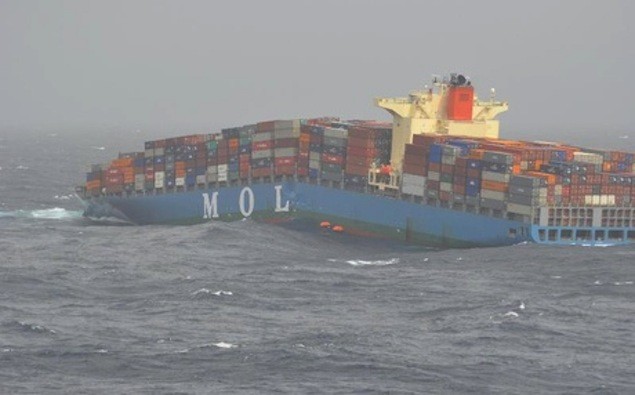
This photo of the MOL Comfort shows considerable hogging. Image credit: IANS
26 crewmembers of an MOL containership were forced to abandon ship Monday off Yemen after the ship suffered from catastrophic hull failure and sank.
India’s IANS News reports that the MV Mol Comfort cracked in half about 200 miles from the Yemeni coast while enroute from Singapore to Jeddah with about 4,500 containers. All 26 crew – made up 11 Russians, 1 Ukrainian and 14 Filipinos - escaped the sinking ship on two life rafts and a lifeboat, the report says.
The Indian Coast Guard in Mumbai diverted three vessels in the area to assist. The MV Yantian Express was first to arrive on scene and rescued the survivors, IANS reports. The 2008-built MOL Comfort sank a short time later.
The incident was confirmed by the ships operator, Mitsui O.S.K. Lines. MOL says that an Emergency Control Headquarters has been established for the incident and MOL is taking company-wide measures to settle the matter.
Weather at the time was strong winds and seas up to six meters.
A castastrophic structural failure
From a naval architecture standpoint, this is a puzzling situation. Ships are designed to handle long period and large waves that crest on the bow and stern and have a trough amidships. This creates a sagging situation that puts extreme tension on the keel and compression at deck level. The opposite, “hogging” situation occurs when the crest of the wave moves to the center of the ship and the trough of the waves are at bow and stern.
The repeat flexing of the ship in these perfectly timed waves is likely what caused the loss of this vessel. In the photo above, a perfect example of hogging is shown, where the bow and the stern are both lying in the troughs of two waves.
It should not have happened however. Ships are built to handle this situation and engineering rules are followed to ensure the transverse “section modulus” of the vessel is sufficient to handle these extreme stresses imposed by nature. There are other possibilities however…
The loading of the containers on board may have exacerbated the situation. Although the loading of the containers appears even in the photo, the weight distribution of the containers may not have been even. Had heavier containers been loaded on the bow and stern and lighter ones in the center of the ship, the vessel may have been placed in a hogging situation before she even set sail. It’s speculation of course to say one way or another, but assuming that she met class requirements, it’s one possible explanation for what happened.
- Mike Schuler and Rob Almeida



